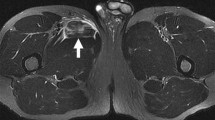Abstract
The mechanically stimulated idiomuscular contraction of skeletal muscles is part of the widely used compound method for death time estimation and therefore represents an item of high relevance and practicability in forensic case work. However, data on the topic are scarce and inconsistent and the currently reported maximum time span for the occurrence of the phenomenon until 13 h post-mortem (hpm) is based on a single case report from the beginning of the twentieth century. Therefore, idiomuscular contraction following mechanical stimulation has been investigated in skeletal muscles of 270 cases with assured time of death at defined post-mortem time points between 7 and 15 hpm. Of all investigated cases, 45 (16.7%) showed a positive reaction with a preponderance of cases of sudden death. Our investigations confirmed the upper time limit of 13 hpm up until idiomuscular contraction could be stimulated. With every hour of the post-mortem interval, a 0.61-fold decrease of the phenomenon's occurrence was observed (95%CI, 0.52–0.72; p < 0.001). Furthermore, several parameters showed significant correlations with the likelihood of the phenomenon's occurrence, namely stimulation of upper arm as opposed to the thigh (p < 0.001), gender (p = 0.017), and BMI (p < 0.001). These findings for the first time give reliable evidence of a post-mortem time limit of mechanically stimulated idiomuscular contraction and therefore contribute to the future application of the method in forensic case work.






Similar content being viewed by others
References
Henssge C, Madea B (2004) Estimation of the time since death in the early post-mortem period. Forensic Sci Int 144:167–175
Henssge C, Madea B (2007) Estimation of the time since death. Forensic Sci Int 165:182–184
Dowler B (1846) Experimental researches on the post-mortem contractility of the muscles, with observations on the reflex theory. New York J Med 8:305–339
Hofmann E (1884) Gerichtsarzneikunde bei Untersuchungen an leblosen Gegenständen. In: Virchow R, Hirschwald A (eds) Jahresberichte über die Leistungen und Fortschritte in der gesamten Medizin, vol 19. Verlag August Hirschwald, Berlin, p 463
Chiari H (1913) Leichenerscheinungen, Leichenbeschau. In: Chiari H, Haberda A, Kolisko A (eds) Handbuch der ärztlichen. Sachverständigentätigkeit, vol. 2. Wilhelm Braumüller, Wien, pp 14–15
Dotzauer G (1958) Idiomuskulärer Wulst und postmortale Blutung bei plötzlichen Todesfällen. Dtsche Z gerichtl Med 46:761–771
Popwassilew I, Palm W (1960) Über die Todeszeitbestimmung in den ersten 10 Stunden. Z f ärztl Fortbild 12:734–737
Semmler J (1979) Einfluss der Umgebungstemperatur auf die Todeszeitbestimmung durch elektrische Reizung der Oberlidmuskulatur menschlicher Leichen. Dissertation, University of Magdeburg, Germany
Joachim H (1988) Mechanische und elektrische Erregbarkeit der Skelettmuskulatur. In: Henssge C, Madea B (eds) Methoden zur Bestimmung der Todeszeit an Leichen. Schmidt-Römhild, Lübeck, pp 32–73
Madea B (2002) Postmortem mechanical excitation of skeletal muscle. In: Henssge C, Knight B, Krompecher T, Madea B, Nokes L (eds) The estimation of the time since death in the early postmortem period, 2nd edn. Arnold, London, pp 160–164
Zsakó S (1916) Die Bestimmung der Todeszeit durch die muskelmechanischen Erscheinungen. Münch med Wochenschr 63:82–83
Zsakó S (1941) Die Bestimmung des Todeseintrittszeitpunktes. Psychiatr neurol Wochenschr 43:66–69
Payne-James J, Byard R, Corey T (2005) Encyclopedia of forensic and legal medicine, 1st edn. Elsevier Academic, Oxford
Di Maio V, Di Maio D (2001) Forensic pathology, 2nd edn. CRC, London
Saukko P, Knight B (2004) Knight’s Forensic Pathology, 3rd edn. Arnold, London
Tracqui A (2000) Time since death. In: Siegel JA, Saukko PJ, Knupfer GC (ed) Encyclopedia of forensic sciences, 1st edn, Vol. 3, Academic, London, pp 1360-1363
Schleyer F (1975) Todeszeitbestimmung im frühpostmortalen Intervall. In: Mueller B, Gerichtliche Medizin, 2nd edn., Vol. 1, Springer, Berlin, pp 55-62
Henssge C, Madea B (2004) Leichenerscheinungen und Todeszeitbestimmung. In: Brinkmann B, Madea B (eds) Handbuch gerichtliche Medizin. Springer, Berlin, Heidelberg, pp 79–225
AMASoft Deathtime, 2.00 (2010). Available at http://www.amasoft.de
Näcke P (1911) Die Dauer der postmortalen mechanischen Muskelerregbarkeit bei chronisch Geisteskranken, speziell Paralytikern. Z ges Neurol Psychiatr 7:424–446
Henssge C, Linkenheimer PP, Salomon O, Madea B (1985) Informationsgehalt der postmortalen elektrischen Erregbarkeit der Skelettmuskulatur für die Todeszeit. Beitr gerichtl Med 43:319–322
Kimura A, Ishida Y, Hayashi T, Nosaka M, Kondo T (2011) Estimating the time of death based on the biological clock. Int J Legal Med 125:385–391
Muggenthaler H, Sinicina I, Hubig M, Mall G (2011) Database of post-mortem rectal cooling cases under strictly controlled conditions: a useful tool in death time estimation. Int J Legal Med. doi:10.1007/s00414-011-0573-6
Hubig M, Muggenthaler H, Sinicina I, Mall G (2011) Body mass and corrective factor: impact on temperature-based death time estimation. Int J Legal Med 125:437–444
Biermann FM, Potente S (2011) The deployment of conditional probability distributions for death time estimation. Forensic Sci Int 210:82–86
Anders S, Kunz M, Gehl A, Sehner S, Raupach T, Beck-Bornholdt HP (2011) Estimation of the time since death—reconsidering the re-establishment of rigor mortis. Int J Legal Med. doi:10.1007/s00414-011-0632-z
Orsós F (1935) Die vitalen Reaktionen und ihre gerichtsmedizinische Bedeutung. Beitr Pathol Anat 95:63–237
Author information
Authors and Affiliations
Corresponding author
Rights and permissions
About this article
Cite this article
Warther, S., Sehner, S., Raupach, T. et al. Estimation of the time since death: post-mortem contractions of human skeletal muscles following mechanical stimulation (idiomuscular contraction). Int J Legal Med 126, 399–405 (2012). https://doi.org/10.1007/s00414-011-0665-3
Received:
Accepted:
Published:
Issue Date:
DOI: https://doi.org/10.1007/s00414-011-0665-3




